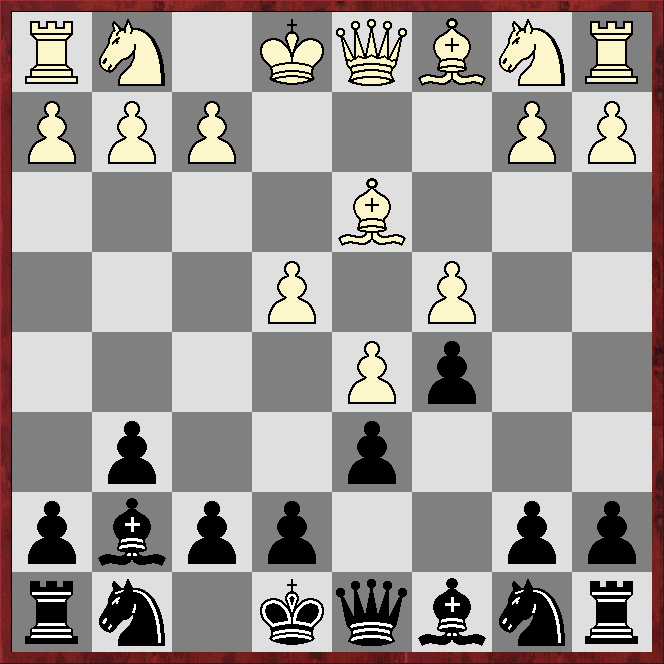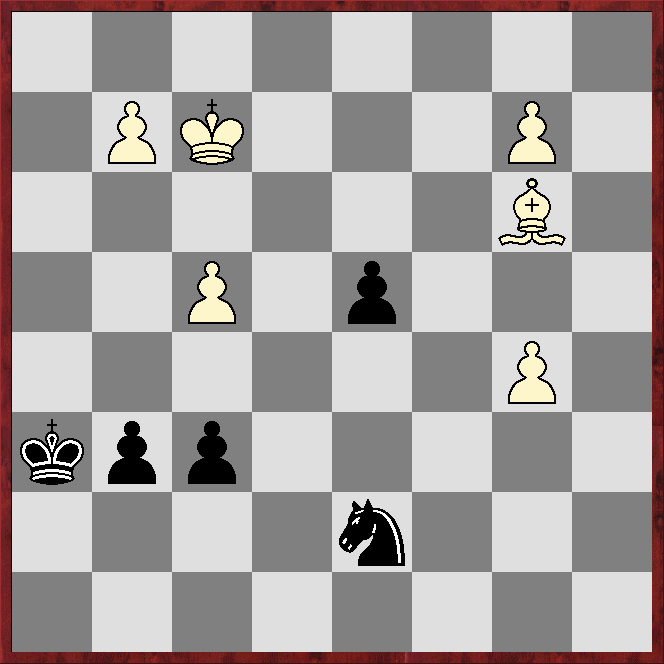IN addition to the main swisses at Mariánské Lázně, there were three round-robin norm events - two for would-be international masters, and one for potential grandmasters.
The GM norm tournament featured four Fide masters, three international masters and three grandmasters.
Top seed was Ukrainian Anton Korobov, whose 2627 rating put him more than 100 elo clear of the field.
His score of +4=5-0 won the tournament by a half-point, but cost him 6.5 elo (since he has a K factor of 10, that is the equivalent of most rated players losing 13 elo, ie scoring 0.65 points less than expected).
Second was Indian international master G B Harshavardhan, whose score +5=2-2 gained 15 elo (since he also has a K of 10, that means he scored 1.5 points points more than expected).
Their round-six game proved pivotal.
Harshavardhan (2405) - Korobov (2627)
French Winawer
1.e4 e6 2.d4 d5 3.Nc3 Bb4 4.e5 c5 5.a3 Bxc3+ 6.bxc3 Ne7 7.Qg4 cxd4!?
Much more popular are 7...0-0 and especially 7...Qc7. The text can easily transpose into the latter, but both sides have chances for independent play.
 |
| How should White respond? |
*****
*****
*****
*****
*****
8.cxd4!?
The main line in ChessBase's 2025 Mega database runs 8.Qxg7 Rg8 9.Qxh7 Qc7 10.Ne2 Nbc6 11.f4 Bd7 12.Qd3 dxc3 13.Nxc3, with a slight edge for White, according to Stockfish17 and Dragon1.
8...Qc7 9.Ra2!?
An awkward-looking defence of c2 that, at least for a while, is the top choice of Dragon1.
 |
| How should Black respond? |
*****
*****
*****
*****
*****
9...Nf5
The engines reckon Black has equalised.
10.Nf3 Nc6 11.Bb2!?
This scores 75%, albeit from a very small sample (just six games) in Mega25, but is strongly disliked by the engines, which prefer 11.Bd3 and 11.Kd1!?
11...Qa5+ 12.c3 b6 13.Qf4!?
Apparently a novelty, the point of which will become clear next move. The engines prefer the known 13.Nd2.
13...Ba6 14.g4!? Nfe7 15.h4 Qa4!?
Black is better after this, according to the engines, but they reckon stronger is 15...Bxf1.
16.Bxa6 Qxa6 17.h5 Qd3!? 18.Ra1
The engines prefer 18.Nd2.
18...Qc2 19.Qd2 Qe4+ 20.Qe3 Qxg4
 |
| Black has won a pawn, and has at least the upper hand, according to the engines, but the position looks murky, at least to me |
*****
*****
*****
*****
*****
21.Ke2 Qf5 22.Rag1 Qc2+ 23.Qd2 Qe4+ 24.Qe3 Qc2+ 25.Qd2 Qxd2+ 26.Kxd2 Nf5
 |
| Black has consolidated the extra pawn, and has got queens off the board; White has some kingside pressure, but needs to somehow get the bad bishop into play |
*****
*****
*****
*****
*****
27.Kd3 h6 28.a4 Kd7 29.Ba3 Rag8 30.Nh4 Nce7!? 31.Bxe7 Nxe7
 |
| With the bishop gone, how big would you assess Black's advantage? |
*****
*****
*****
*****
*****
White has a fair bit of compensation for a pawn, according to the engines, which give Black just a slight edge.
32.Rg4
The engines prefer 32.Ng2!?, intending Ne3, or 32.Rb1, intending a5.
32...g6 33.hxg6 fxg6 34.f4 g5 35.Nf3?!
The engines point out that 35.Ng2 threatens to equalise with fxg5, and after 35...gxf4 36.Rxg8 Rxg8 37.Nxf4 the white knight is well-placed to restrain the h pawn and pressure e6.
35...Rf8 36.Ke3 Rxf4 37.Rxf4 gxf4+ 38.Kxf4 Rf8+ 39.Kg4 Nf5!?
Even stronger may be first 39...Rg8+ and then ...Nf5.
40.Nh4 h5+!? 41.Kg5 Rg8+ 42.Kf6 Ne7!?
The engines at first strongly dislike this, preferring 42...Ng3, or 42...Rf8+ and then ...Ng3. However the text comes to be Dragon1's top choice, although Stockfish17 continues to prefer the alternatives.
43.Rh3 a5!?
This gives Black a backward b pawn, but is the engines' immediate top-choice, although Stockfish17 comes to prefer 43...Rg1 and 43...Rg4. The idea, I am fairly sure, is to create the threat of ...b5, followed, after axb5, by a quick advance of the a pawn.
44.Nf3?
The engines suggest 44.Rh2!? or 44.Rh1!?
44...h4!
Also very strong is 44...b5!
 |
| How should White continue? |
*****
*****
*****
*****
*****
45.Nxh4
Walking into a pin, but the move seems forced, eg 45.Rxh4? loses the knight to 45...Rf8+ etc, while moving the knight away, eg 45.Nd2?, allows a quick mate starting with 45...Ke8! Finally, withdrawing the rook to h2 or h1 also loses the knight to 45...Rf8+ etc.
45...Rh8 46.Rh2
 |
| Black to play and win |
*****
*****
*****
*****
*****
46...Nf5?
There is only one winning move: 46...Rh5!, when, unlike in the game, 47.Nf3? loses to 47...Rf5+ etc. If White instead shuffles the rook, for example to h3, then 47...Nf5 wins, while 47.Kf7 (best, according to the engines) runs into 47...Nf5 48.Nf3 Nd6+! 49.exd6 Rf5+ 50.Kg6 Rxf3 with a winning rook-and-pawn ending.
47.Rb2?
Incredible. I suspect most club players would play the correct 47.Nf3, even if they could not work out whether it really does draw. In fact after 47...Rxh2 48.Nxh2 b5!? 49.axb5 a4, presumably the sequence Harshavardhan feared, both 50.Nf3 and 50.Nf1 draw, eg 50.Nf3 a3 51.Nd2 a2 52.Nb3, or 50...Ne3 51.Nd2 (among other moves, 51.Ng5!? also draws, according to the engines), and here Black has to be careful as 51...Nd1?? loses to 52.Nb1, thanks to the deflecting power of pushing the b pawn, eg 52...Ne3 53.b6 etc.
47...Rxh4 48.Rxb7 Rf4!
Other moves also win, but the engines agree this is best.
49.Rb7+
Or 49.Kg5 Rf3, winning the c pawn.
49...Kc6 50.Ra7 Nxd4+ 51.Ke7 Nb3 52.Ra6+ Kc7 53.Ra7+
Little better is 53.Rxe6, when several moves win, including the simple 53...Rxa4, eg 54.Rd6 d4!? 55.cxd4 Rxd4 56.Ra6 a4 57.e6 Kb7 etc.
53...Kb6 54.Ra8 Nc5 55.Kd6 Rxa4 56.Rb8+ Ka7 57.Rc8 Rc4!? 58.Rxc5!?
There is nothing better, but the pawn-ending is lost.
58...Rxc5 59.Kxc5 Ka6!?
The key move - easy to find here, but difficult to see from afar.
60.Kd6
Or 60.c4 dxc4 61.Kxc4 Kb6 etc.
60...a4 61.Kxe6 a3 62.Kf7 a2 63.e6 a1=Q 64.e7 Qf1+ 65.Ke6 Qe2+ 66.Kd7 Kb5 0-1


















































